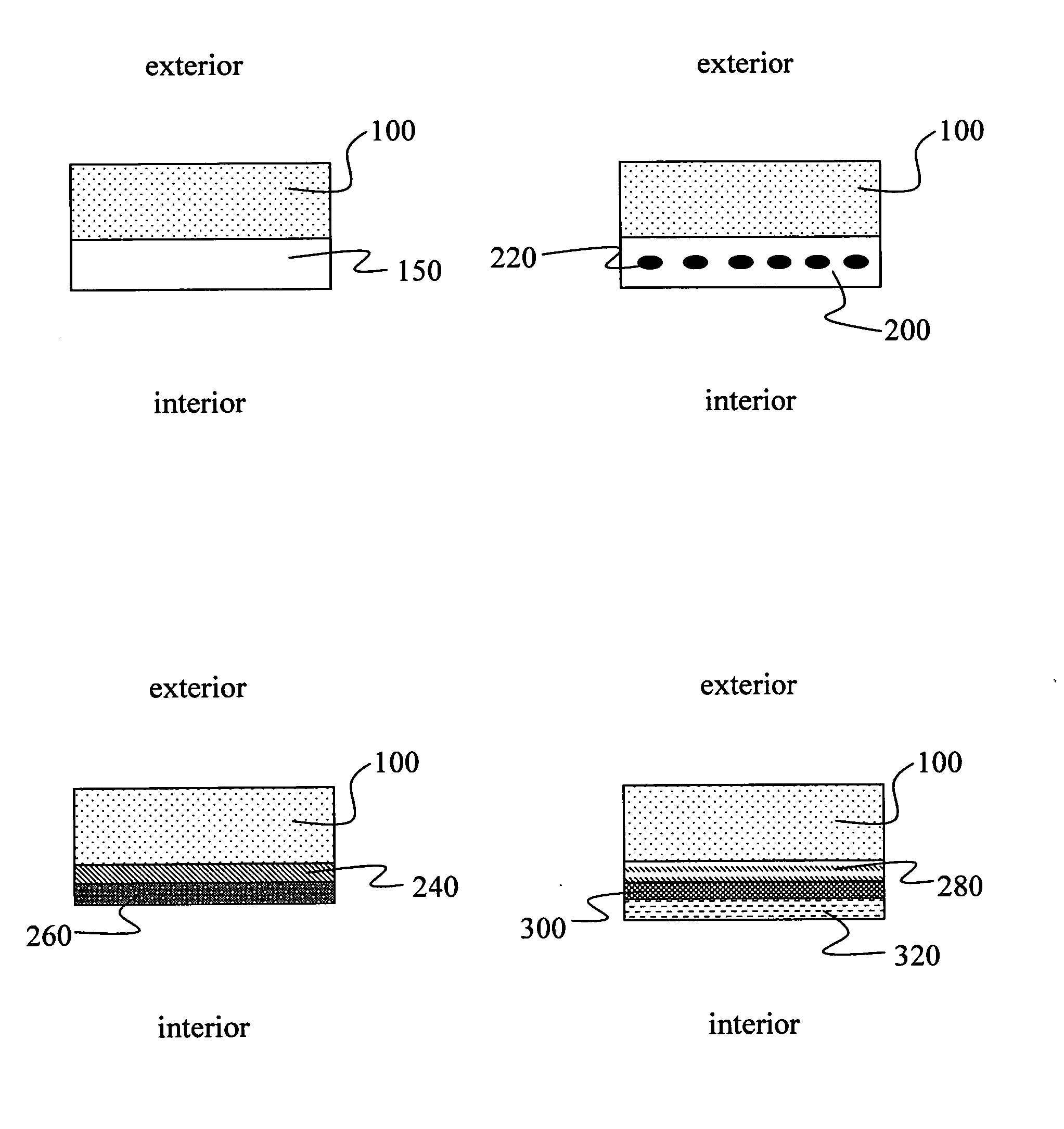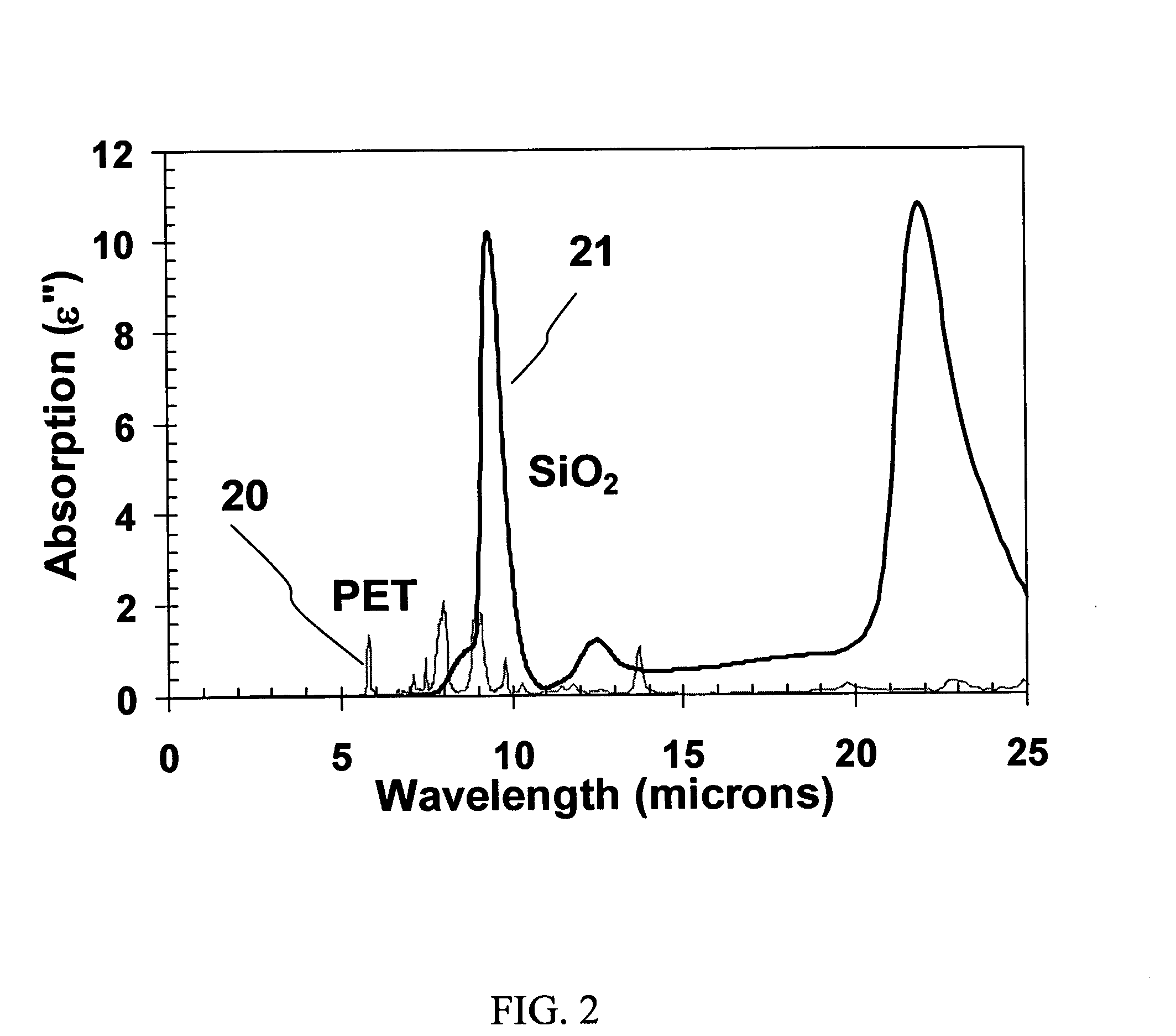Thermal barrier
a technology of thermal barrier and thermal barrier, which is applied in the field of thermal barrier, can solve the problems of high glass intrinsic cost, inconvenient movement or reconfiguration, and heavy glass barrier, and achieves high free electron concentration, high insulative performance, and high infrared coupling of thermal radiation
- Summary
- Abstract
- Description
- Claims
- Application Information
AI Technical Summary
Benefits of technology
Problems solved by technology
Method used
Image
Examples
example 1
[0055]In this example, the properties of a thermal barrier according to the instant invention are described. FIG. 5 compares the reflectance spectra of a 5 mil thick sample of PET (Mylar, trace labeled “PET”), a 5 mil thick sample of SiO2 (fused silica glass, trace labeled “FSG”) and a thermal energy barrier that includes a 2 μm thick layer of SiO2 as infrared active layer on a 5 mil thick PET support layer (trace labeled “2.0 μm on SiO2 on PET”). The traces shown for PET and FSG are reproduced from FIG. 3. The trace shown for the thermal energy barrier indicates that the instant barrier material provides infrared reflection characteristics that are superior to those of SiO2 alone. First, it is noteworthy that a 2 μm thick layer of SiO2 is thick enough to incorporate the infrared reflection characteristics of the 5 mil thick SiO2 sample. This confirms that the surface region of SiO2 (or other vibrational infrared active materials) is primarily responsible for the thermal insulative ...
example 2
[0058]In this example, the beneficial effect of nanoscale regions of Al is demonstrated through simulation. The free carrier absorption characteristics of Al vary with the particle size of Al. Maximum free carrier absorption occurs for bulk Al and the free carrier absorption decreases as the particle size decreases due to a decrease in the concentration of free carriers as the dimensions of Al particles decrease. In this example, the free carrier concentration Ne and optical constants of bulk Al were determined through a Drude-Lorentz analysis of optical data in the visible to near-infrared spectral range and the results were applied to compute the reflectance and transmission spectra of Al films having a thickness of 1.0 nm over a range of Al particle sizes.
[0059]FIG. 8 summarizes the results of the spectral response and thermal efficiency of Al as a function of particle size, where free carrier concentration Ne was utilized as a proxy for particle size. The results were simulated ...
example 3
[0063]In this example, the instant infrared active materials are applied to clothing. In clothing applications, it is desirable to achieve retention of body heat in cold climates. The body is an approximately fixed temperature thermal source that emits infrared radiation. Retention of infrared radiation emitted from the body keeps the body warm and prevents heat loss to the surroundings. The enhanced thermal insulative effects described hereinabove extend to the fabrics, cloth, fibers, and threads used to make clothing.
[0064]FIG. 9 depicts an embodiment in which an infrared active material is formed on the exterior surface of textile. Textile 60 is a natural or synthetic material formed from threads 61 that include fibers 62. After manufacture, the interior and exterior surfaces of the textile may be treated with an infrared active material according to the instant invention. The interior surface of the textile is the side in contact with the body and the exterior surface is the sid...
PUM
| Property | Measurement | Unit |
|---|---|---|
| Efficiency | aaaaa | aaaaa |
| Nanoscale particle size | aaaaa | aaaaa |
| Nanoscale particle size | aaaaa | aaaaa |
Abstract
Description
Claims
Application Information
 Login to View More
Login to View More - R&D
- Intellectual Property
- Life Sciences
- Materials
- Tech Scout
- Unparalleled Data Quality
- Higher Quality Content
- 60% Fewer Hallucinations
Browse by: Latest US Patents, China's latest patents, Technical Efficacy Thesaurus, Application Domain, Technology Topic, Popular Technical Reports.
© 2025 PatSnap. All rights reserved.Legal|Privacy policy|Modern Slavery Act Transparency Statement|Sitemap|About US| Contact US: help@patsnap.com



